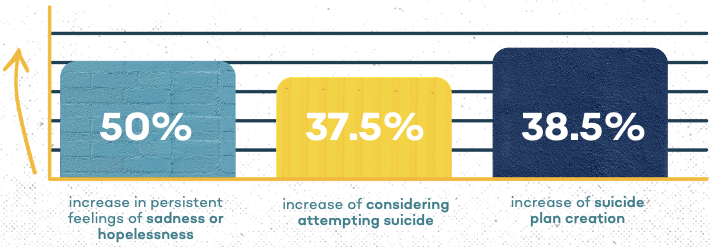Youth Mental Health Crisis
The modern teenage experience is unlike anything previous generations have lived through. Along with the conveniences that a more connected society brings, teens are navigating uncharted, complex territory, with many factors contributing to the youth mental health crisis in recent years.
Staggering new statistics from the CDC’s Youth Risk Behavior Survey Report show that teens continue to experience high levels of risk, with poor mental health and suicidal thoughts and behaviors increasing for nearly all groups of youth. Trends are particularly high for teen girls, with almost 30% having seriously considered suicide and 57% reporting feelings of persistent sadness or hopelessness.
From 2011 to 2021, high school students reported:

Suicide remains the third leading cause of death for ages 10-24. The risk is even greater for LGBTQ+ high school students, who report attempting suicide at a nearly four times higher rate than heterosexual classmates. The data is clear that teens are struggling. Yet, in many spaces, youth are met with dismissive attitudes that stem from the social stigma that surrounds mental health discourse. They are too often told to “get over it,” “toughen up” or made to believe that they’re “just looking for attention.”
So, what can be done to better support our teens? The CDC’s report “raises urgency for the need to invest in schools as a lifeline to help struggling youth.”
School-Based Opportunities to Address the Crisis
School connectedness was highlighted by the report as one form of action that can have a strong and lasting impact on areas where young people are struggling, including mental health. As defined by the CDC, school connectedness is when students feel that adults and peers in their school environments care about their learning as well as their individual wellbeing.
School-based mental health education and support have been proven to make a profound difference. Effective approaches include connecting teens to their peers and communities through clubs and community outreach and providing safe and trusted adults, such as trained teachers — increasing the belief among students that they are cared for, supported and belong. Fostering this school connectedness with classmates and staff, and equipping high school students with essential skills, such as managing emotions and asking for help, makes teens less likely to experience poor mental health.
Based on this information, we feel confident that teen-led mental health campaigns like Zero Reasons Why are needed now more than ever – and have the potential to make a tremendous impact. Zero Reasons Why was born out of crisis but sets its focus on equipping teens to create a better future for themselves and their communities. Teens are ready to lead the way. We just can’t do it without support.
We are actively seeking sponsors and friends of the movement to help us broaden our reach so people in every community can unite to prevent teen suicide. If you’d like to become a partner or sponsor of the Campaign, check out our sponsorship prospectus, which contains information about the history, structure and growth goals of the Campaign, or reach out to our Campaign Team.

